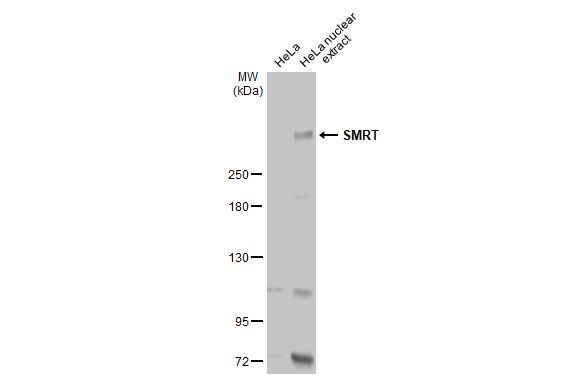Anti-SMRT Antibody (56217)
$503.00
SKU: 56217
Categories: Antibody Products, Neuroscience and Signal Transduction Antibodies, Products
Overview
Product Name Anti-SMRT Antibody (56217)
Description Anti-Smrt Mouse Monoclonal Antibody
Target SMRT
Species Reactivity Human
Applications WB,ICC/IF,IP
Host Mouse
Clonality Monoclonal
Clone ID H7
Isotype IgG1
Immunogen A KLH-conjugated synthetic peptide derived from human SMRT corresponding to aa 994-1005
Properties
Form Liquid
Concentration Lot Specific
Formulation 10 mM PBS, pH 7.4.
Buffer Formulation Phosphate Buffered Saline
Buffer pH pH 7.4
Format Purified
Purification Purified by immunoaffinity chromatography
Specificity Information
Specificity This antibody recognizes human SMRT.
Target Name Nuclear receptor corepressor 2
Target ID SMRT
Uniprot ID Q9Y618
Alternative Names N-CoR2, CTG repeat protein 26, SMAP270, Silencing mediator of retinoic acid and thyroid hormone receptor, SMRT, T3 receptor-associating factor, TRAC, Thyroid-, retinoic-acid-receptor-associated corepressor
Gene Name NCOR2
Sequence Location Nucleus.
Biological Function Transcriptional corepressor (PubMed:20812024). Mediates the transcriptional repression activity of some nuclear receptors by promoting chromatin condensation, thus preventing access of the basal transcription. Isoform 1 and isoform 4 have different affinities for different nuclear receptors. Involved in the regulation BCL6-dependent of the germinal center (GC) reactions, mainly through the control of the GC B-cells proliferation and survival. Recruited by ZBTB7A to the androgen response elements/ARE on target genes, negatively regulates androgen receptor signaling and androgen-induced cell proliferation (PubMed:20812024). {PubMed:18212045, PubMed:20812024, PubMed:23911289}.
Research Areas Neuroscience
Background SMRT (Silencing Mediator for Retinoid and Thyroid receptors) is a 168 kD nuclear protein. Nuclear hormone receptors are transcription factors regulated by ligand binding. In the absence of ligand, there is a physical interaction between the nuclear receptors that do not interact with Hsp90 and a family of corepressors which includes SMRT. SMRT helps target histone deacetylases and other components of a multiprotein repressor complex to the specific target promoter to silence gene transcription.
Application Images


Description HeLa whole cell and nuclear extracts (30 ug) were separated by 5% SDS-PAGE, and the membrane was blotted with SMRT antibody [1542] (56217) diluted at 1:1000. The HRP-conjugated anti-mouse IgG antibody was used to detect the primary antibody, and the signal was developed with Trident ECL plus-Enhanced.
Handling
Storage This antibody is stable for at least one (1) year at -20°C. Avoid multiple freeze- thaw cycles.
Dilution Instructions Dilute in PBS or medium which is identical to that used in the assay system.
Application Instructions Immunoblotting and
Immunoprecipitation: use at 1-5 ug/mL.
Positive control: HBL100
Immunoprecipitation: use at 1-5 ug/mL.
Positive control: HBL100
References & Data Sheet
References Iftode, C et al. 1999. Crit Rev Biochem Mol Biol 34: 141-180
Bochkarev, A et al. 1999. EMBO 18: 4498-4504
Dong, J et al. 1999. Biochem J 337: 311-317
Sibenaller, ZA et al. 1998. Biochemistry 37: 12496-12506
Stigger, E et al. 1998. J Biol Chem 273: 9337-9343
Bochkareva, E et al. 1998. J Biol Chem 273: 3932-3936.
Bochkarev, A et al. 1999. EMBO 18: 4498-4504
Dong, J et al. 1999. Biochem J 337: 311-317
Sibenaller, ZA et al. 1998. Biochemistry 37: 12496-12506
Stigger, E et al. 1998. J Biol Chem 273: 9337-9343
Bochkareva, E et al. 1998. J Biol Chem 273: 3932-3936.
Data Sheet  Download PDF Data Sheet
Download PDF Data Sheet
 Download PDF Data Sheet
Download PDF Data Sheet


